What does it mean to live a modern life?
Where you live has a critical impact on your lifestyle, your options, community services and even your health. Historically, the transition from rural to urban has meant that a household has options to use specialties the community offers and not to rely entirely on its own resources. A bakery can supply bread, a hospital health care, transportation services like buses or taxis, a school graded classrooms and clubs social outlets. On the other hand, rural families avoid urban noise and often pollution, ethnic tensions from different neighborhoods and sometimes the loss of tight-knit neighborhoods and family connections. Depending on one's priorities, urban or rural living may have more or less appeal.
Rural, Urban Growth
For the first time in American history, the urban population surpassed the rural population in the 1920 U.S. Census. The census showed that 51.2 percent of Americans lived in cities with a population over 2,500 (the definition of urban). In Iowa, rural residents still commanded a distinct majority with 36 percent. But there was a definite trend toward urban living, especially in the big cities in the East, and many Iowans found this disturbing. Descendents of Northern Europeans countries (British Isles, Germany, Scandinavia, Ireland) had traditionally dominated the countryside throughout the 19th century, but Eastern and Southern European immigrants had been swelling Boston, New York, Philadelphia and the manufacturing centers around the Great Lakes. Railroads and automobiles had greatly increased travel exposing Iowa residents to urban values that threatened long-standing traditions. World War I had witnessed the beginning of mass migrations of African-Americans to Northern cities creating new racial tensions. Additionally, due to the collapse of high wartime practices and agriculture growing surpluses created by wartime stimuli, Americans experienced economic hardship.
American values were in flux in the early 1900s. Prohibition was officially the law of the land with the passage of the 18th Amendment but the bootlegging industry and widespread disregard of the law created tensions. The rise of motion pictures and radio brought images of urban life to rural areas. As troops returned home from the fighting in Europe, many hoped that the U.S. could withdraw from international affairs and return to a more isolated foreign policy, but world affairs continued to draw America into diplomatic issues. Technology, economics and political tensions prevented the United States from returning to the pre-war "normalcy" - as President William Harding described it - and the nation would face unprecedented challenges in the coming years with the Great Depression, World War II and the onset of the Cold War in the Atomic Age.
Supporting Questions
What did modern life look like at the beginning of the 20th century?
- "Typical Eastern City" Newspaper Article, September 1, 1900 (Document)
- State Street in Chicago, Illinois, 1905 (Image)
- Iowa City, Iowa, 1907 (Image)
- Fort Dodge, Iowa, 1907 (Image)
- Interview of Harry Reece about His First Trip to Chicago, Illinois, November 29, 1938 (Document)
What did rural life look like at the beginning of the 20th century?
- Woman, Man and Child Between a Corn Field and a Stream in Iowa, 1897 (Image)
- Rural Wagon Delivering Mail, 1903 (Video)
- "Country Life," 1904 (Image)
- Excerpts from the Report of the County Life Commission, 1909 (Document)
- "Special Message from the President of the United States Transmitting the Report of the Country Life Commission," 1909 (Document)
- Family Posed with Haystack and Horse-Drawn Wagon in Dubuque, Iowa, ca. 1910 (Image)
- Children Reading the Sunday Newspaper in Dickens, Iowa, December 1936 (Image)
- Selected Graphs from "Changes in Agriculture," 1950 (Document)
How did rural people advocate for the conveniences of modern life?
- Excerpt from the Annual Report of the Postmaster-General of the United States, 1891 (Document)
- "Rural Mail Report" Newspaper Article, October 24, 1899 (Document)
- Excerpt from "President's Message" about Rural Mail Delivery, December 3, 1900 (Document)
- "Electricity and the Farm" Newspaper Article, February 28, 1901 (Document)
- "Telephones on Farms" Newspaper Article, December 30, 1902 (Document)
What did modern life mean to people at the beginning of the 20th century?
- "The Marvelous Vogue of the Automobile," August 24, 1899 (Document)
- "Is Our Pace Too Fast?" June 18, 1903 (Document)
- "Physical Culture of Beams and Girders," May 12, 1904 (Document)
- "Woman and Her Ways," January 10, 1907 (Document)
- "Thomas Edison Prophesies," July 10, 1907 (Document)
- "Experienced Teacher" and "Newspapers" Article, October 12, 1907 (Document)
| Rural Life in a Modern Age Teaching Guide |
| Printable Image and Document Guide |
"Experienced Teacher" and "Newspapers" Article, October 12, 1907
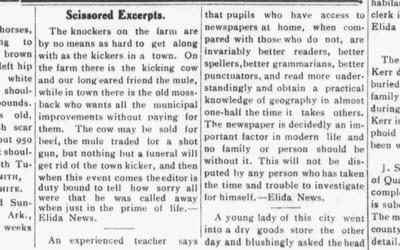
Description
By the end of the 19th century, many children were attending primary school, but most did not attend high school and even fewer attended college or university. The newspaper industry was highly competitive. Major urban areas had multiple papers representing a variety of…
"Thomas Edison Prophesies," July 10, 1907
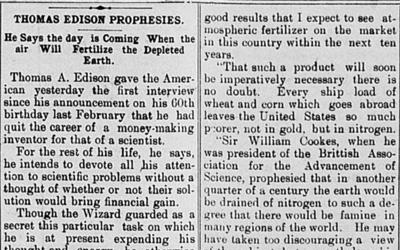
Description
By the early 20th century, Thomas Edison was a well-known inventor whose work on the incandescent light bulb, as well as the phonograph and other inventions would have been well known.
"Woman and Her Ways," January 10, 1907
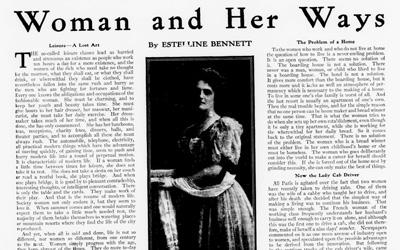
Description
This essay by Estelline Bennett looks at the roles and "ways" of a woman in a modern age. The publication was printed in the Wood County Reporter in 1907.
"Typical Eastern City" Newspaper Article, September 1, 1900

Description
This news article described the towns in Hardin County on a drive from Iowa Falls to Eldora, Iowa. While this account was published in The Eldora Herald, the story was written for publication in the Omaha World-Herald.
State Street in Chicago, Illinois, 1905
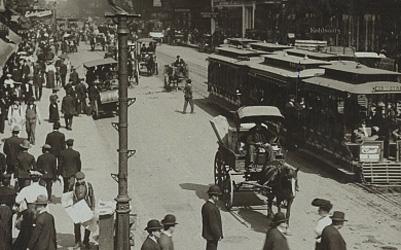
Description
This view of State Street in Chicago, Illinois, is presented as a stereographic image. These images were designed to be used in a viewing device so the viewer would see a 3D image. These images were popular as a way to see other places.
Iowa City, Iowa, 1907
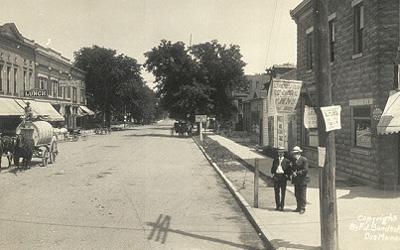
Description
In 1900, Iowa City was the 13th largest city in Iowa. While it saw rapid population growth in the 1850s, population growth slowed after 1860 when the state capital was moved to Des Moines. This image shows a panoramic view of an intersection in the business district of Iowa…
Fort Dodge, Iowa, 1907
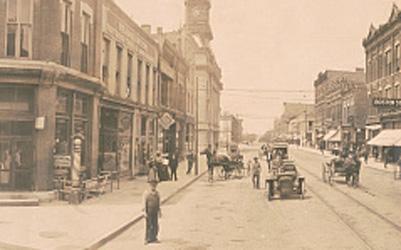
Description
This image shows an intersection in downtown Fort Dodge, Iowa. In 1900, Fort Dodge was the 12th largest city in the state of Iowa. The image shows the streets lined with two- to three-story brick buildings. A few people are walking on the sidewalks. Several horse-drawn…
Interview of Harry Reece about His First Trip to Chicago, Illinois, November 29, 1938

Description
This interview was collected in 1938 by the Federal Writers’ Project, a component of the Work Projects Administration. In the interview, Harry Reece described his first trip to Chicago around 1900. Reece was born and grew up in rural Illinois.
Woman, Man and Child Between a Corn Field and a Stream in Iowa, 1897
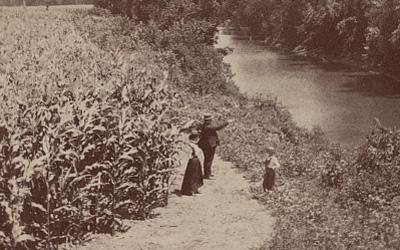
Description
This image is intended to be used in a stereograph viewer. The side-by-side images in the viewer would provide a 3D image. Stereograph images were popular ways to see the world. This image was sold in the United States, Canada and Britain. These side-by-side images show…
Rural Wagon Delivering Mail, 1903
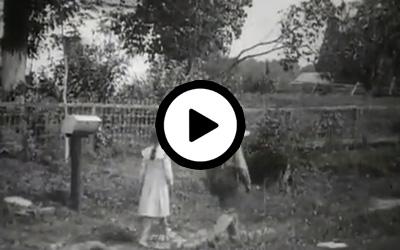
Description
In the early 1890s, Postmaster General John Wanamaker proposed the extension of mail delivery service into the countryside. In U.S. cities, mail delivery to homes began in the 1860s. Wanamaker's proposal gained wide support in rural areas where farm families often went…
"Country Life," 1904
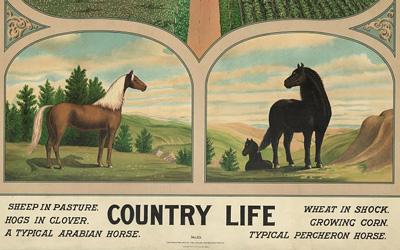
Description
This "Country Life" image was published as part of a collection about rural life. The collection was published in 1904. The bottom third of the image shows a "typical Arabian horse" and a "typical Percheron horse." The top of the image shows a scene with pastures…
Excerpts from the Report of the County Life Commission, 1909
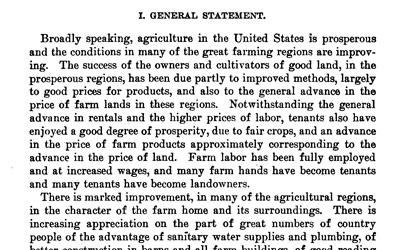
Description
In this summary of their final report, the Commission on Country Life provided information about the strengths of country life but spent most of the report identifying the weaknesses of country life and making recommendations for resolving those problems. This excerpt from…
"Special Message from the President of the United States Transmitting the Report of the Country Life Commission," 1909
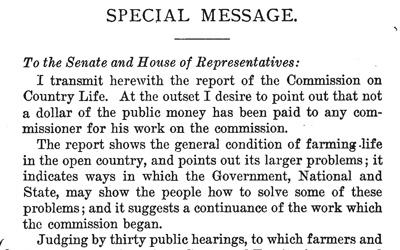
Description
In 1890, two events indicated the changing nature of American life. For the first time, the value of manufactured goods was greater than the value of agricultural goods produced that year. And following the 1890 census, the Census Bureau declared the frontier closed since…
Family Posed with Haystack and Horse-Drawn Wagon in Dubuque, Iowa, ca. 1910
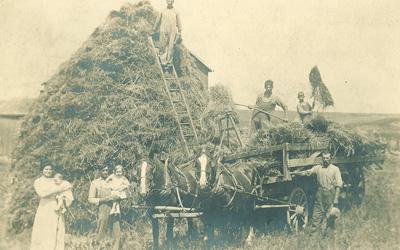
Description
This posed image was taken near Dubuque, Iowa, in the first decade of the 20th century. A postcard was created using this image. Postcards were a relatively new invention at the beginning of the 20th century, and a variety of different images were used to create them. A farm…
Children Reading the Sunday Newspaper in Dickens, Iowa, December 1936
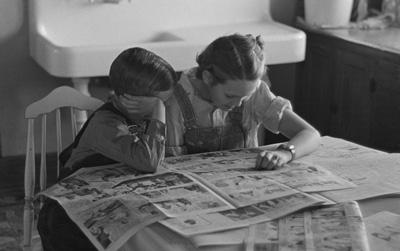
Description
This photograph was taken in the 1930s, a couple of decades after the other images in this set. The photograph came from the U.S. Resettlement Administration and was taken during the Great Depression. The agricultural sector was an area of concern for the U.S. government…
Selected Graphs from "Changes in Agriculture," 1950
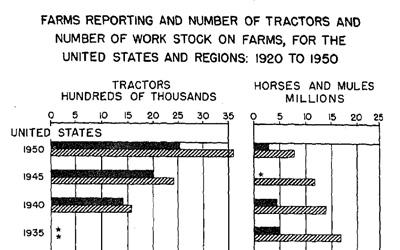
Description
This series of graphs are from a 34-page document published in 1950, detailing the changes that had occurred in agriculture over the previous 50 years. The report covered changing land use patterns and the major agricultural products produced in the United States during that…
Excerpt from the Annual Report of the Postmaster-General of the United States, 1891

Description
In the 1890s, the U.S. Post Office began the rural free delivery of mails. The program began as a few test cases in various places around the country. Rural people very quickly saw the benefits of this service and advocated strongly for the expansion of the program. This…
"Rural Mail Report" Newspaper Article, October 24, 1899

Description
Newspapers regularly reported on the expansion of rural free delivery with the opening or surveying of new routes. These news stories often included information about the program and its success. This report came from one of the government officials responsible for…
Excerpt from "President's Message" about Rural Mail Delivery, December 3, 1900
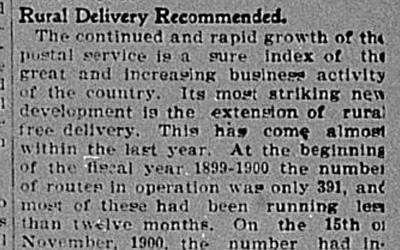
Description
In this address, reported in Marshalltown's Iowa Times Republican, President William McKinley acknowledged the benefits of rural free delivery for farm families.
"Electricity and the Farm" Newspaper Article, February 28, 1901
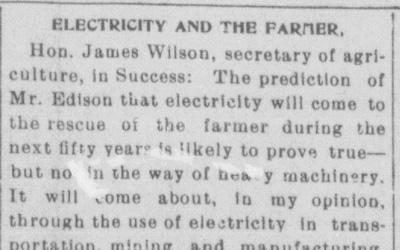
Description
At the beginning of the 20th century, several new inventions were changing life for many Americans, especially in the cities. Some changes were spreading to the countryside, like rural free delivery, while others would take longer to spread through the countryside. While…
"Telephones on Farms" Newspaper Article, December 30, 1902
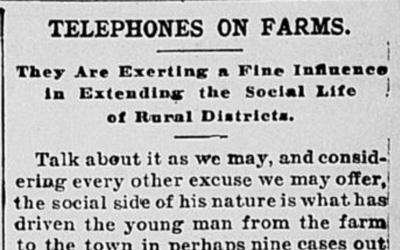
Description
As modern innovations spread in the cities, rural residents also desired access to those conveniences of modern life. Rural life, in particular, was often viewed as isolated, and the telephone seemed a good remedy. This newspaper article looks at the influence and use of…
"The Marvelous Vogue of the Automobile," August 24, 1899
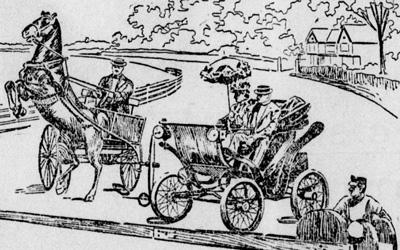
Description
The first automobiles were introduced in the late 19th century. They became more commonly available after 1900 when Henry Ford developed his assembly line production for the Model T.
"Is Our Pace Too Fast?" June 18, 1903
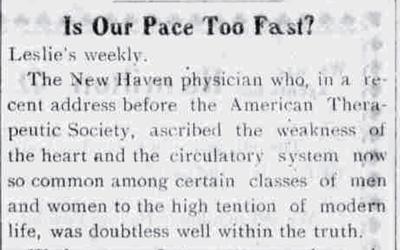
Description
This newspaper article, entitled "Is Our Pace Too Fast?", focuses on the words of a New Haven physician. The doctor said at an address before the American Therapeutic Society that weakness of the heart and the circulatory system are common among certain classes of men…
"Physical Culture of Beams and Girders," May 12, 1904
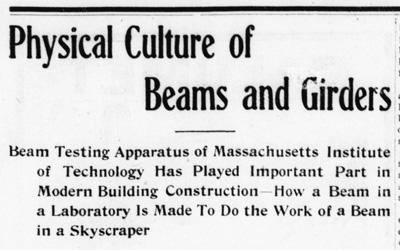
Description
With Bessemer process and later Open-Hearth process, steel could be mass produced and began to be used in a wide variety of ways. In cities, steel girders were used to build much taller buildings.
Additional Resources
- "Good Roads and Rural Free Delivery of Mail" by Wayne E. Fuller
This academic journal article was featured in The Mississippi Valley Historical Review and looks at the transition to rural free delivery of mail around the turn of the 20th century. - "The Changing Nature of Country Roads: Farmers, Reformers, and the Shifting Uses of Rural Space, 1880-1905" by Christopher W. Wells
This journal article follows the progression of road development and its effect on rural America. This includes the passage of the first state-aid road laws, the creation of the first federal road agency and the growth of a strong urban-rural coalition promoting rural road improvements. - "The Revolution in Rural Telephony, 1900-1920" by Claude S. Fischer
This article from the Journal of Social History focuses on the evolution of telephone development and technology in rural America. - "Rural Education Reform and the Country Life Movement, 1900-1920" by David B. Danbom
This article, which was published in the Agricultural History journal, looks at the parallels of education reform and rural America. - Born in the Country: A History of Rural America by David B. Danbom
This book features a general history of rural America. Ranging from pre-Columbian times to the enormous changes of the twentieth century, the book integrates agricultural, technological and economic themes with new questions social historians have raised about the American experience.
Iowa Core Social Studies Standards (9th-12th Grade)
Listed below are the Iowa Core Social Studies content anchor standards that are best reflected in this source set. The content standards applied to this set are high school-age level and encompass the key disciplines that make up social studies for 9th through 12th-grade students.
| No. | Standard Description |
| SS-Geo.9-12.24. | Identify and evaluate Iowans or groups of Iowans who have influenced Iowa’s environmental or cultural geography. |
| SS-US.9-12.18. | Analyze the effects of urbanization, segregation, and voluntary and forced migration within regions of the U.S. on social, political, and economic structures. |
| SS-US.9-12.22. | Evaluate the impact on inventions and technological innovations on the American society and culture. |